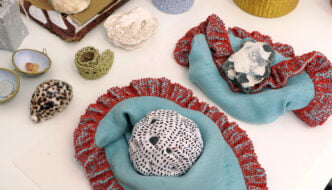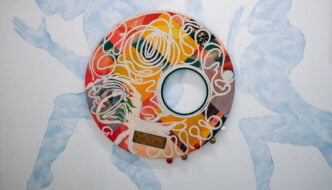‘Binary’ is a term that has, over the last few years, burst into everyday use. Once a fixture of jargon within the computing world, the word – and its antithesis, non-binary – has become prolific in discussions of gender and sexuality. The latter field has done extremely well, nurturing and hatching mature debate on how we establish and perceive the fixed boundaries that ‘binary’ dictates. This aside, it seems ironic that the majority of our exposure to ‘binary’ as a concept – whose definition is ‘relating to, composed of, or involving two things’ – has been conflated down to exactly that: two separate, seemingly unrelated cultural phenomena.
Last week’s exhibition – ‘BINARY’, at Partisan Collective, was a glowing reminder that we need not restrict the potentially limitless examples we can gather under the term’s umbrella. Curators Holly Pollard and Kira Wainstein found the exhibition theme to be ‘the perfect fluid term’ to combine and accentuate their contrasting academic focuses on art and science. They met on an art foundation course and describe many of their friends as being alienated by or uninterested in art. BINARY was carefully and successfully designed as ‘a show that was enjoyable not only for avid exhibition goers, but rather to everyone’. The themes in play ranged from dual heritage to the ‘self’ and the ‘other’, ‘part’ and ‘whole’, blurred time and context.
The clever aspect of the exhibition came from its accessibility not only for the viewer, but also from the artistic sources involved. Aside from the substantial variety in theme, there was just as much ingenuity in form. In Hayley Harman’s ‘Fresh Eyes to See My Worm’, consisting of a more traditional, painted medium of art, colours twisted among each other, representing a string of decontextualized sentences stitched together. The piece invited a question into the relationship between language and painting, casting a spotlight on the ‘imperfect presence of the author and translator’.
Elsewhere, a series of clay swirls, each uniquely shaped and formed from a free-flowing process, were placed, grid-like on sand in the middle of the exhibition. George Coldwell’s work challenged the limits of natural shape versus the regimentation and organised confines of industrial building. The depth of its interpretation was enhanced by its position in the room, allowing for perspective changes that seemed to continuously warp the composition of the clay folds themselves. It was an interesting take that demonstrated the variability of nature within prison-like limits imposed in built areas.
The playfulness of the collected works helped the curators’ desire to make the whole experience open and unintimidating. A comical feature was a sheet of silicon-like material studded with jutting noses, fluttering via fans behind them as though sniffing the air. Candice Dehnavi’s dip into absurdity was mirrored by Andrea Christodoulides, whose silk pieces: ‘Caterpillar God Shit Me Money!’ and ‘Run! Run! Run!’ were made relatable to a largely young audience by looking into the anxieties and uncertainties of university graduation.
BINARY was a show that succeeded on a variety of levels. Not only did it provide a thorough examination and re-contextualisation of its theme, but the selected art spanned from the thought-provoking to the fun and the strange, capturing the essence of binary forces.




Comments